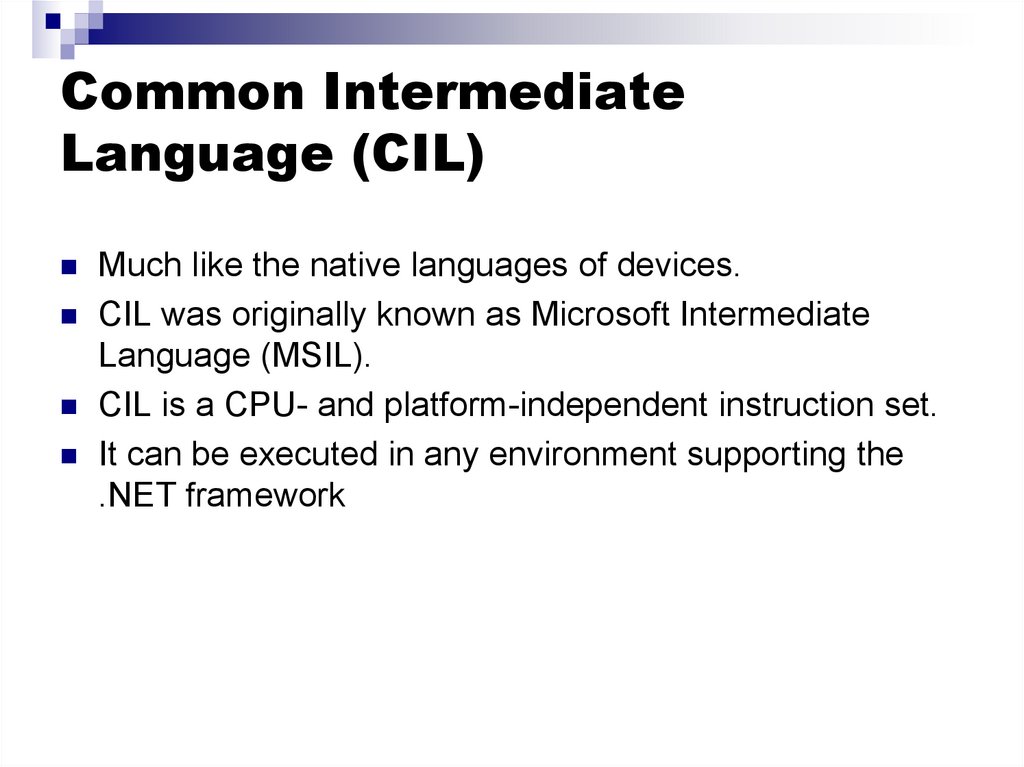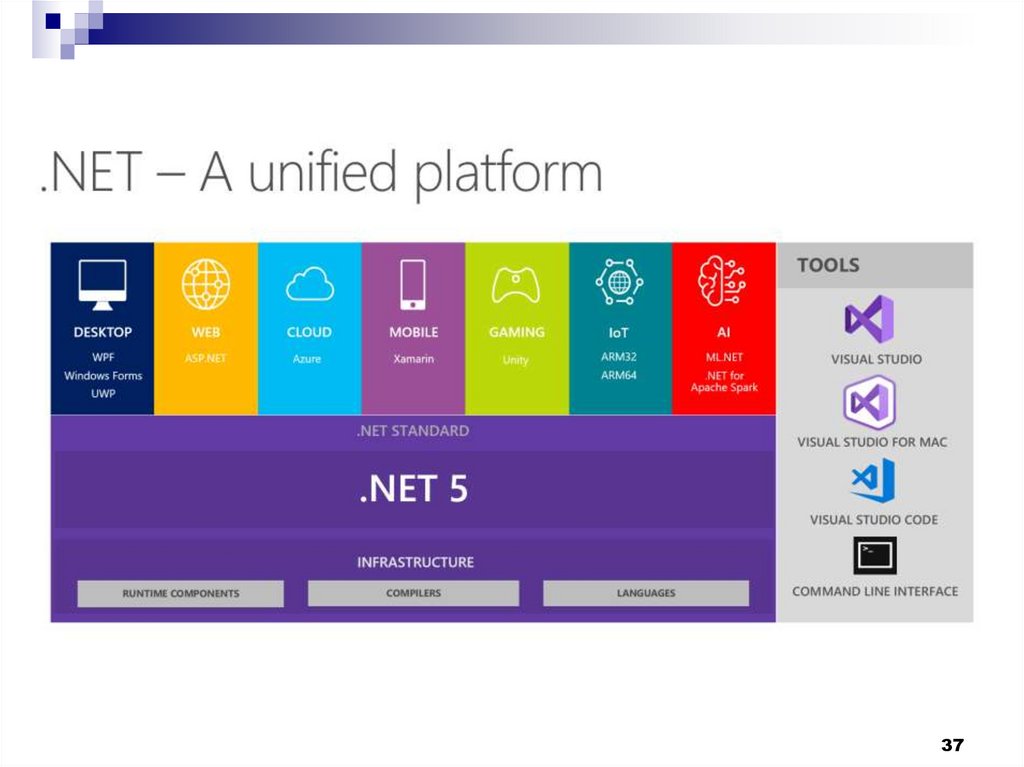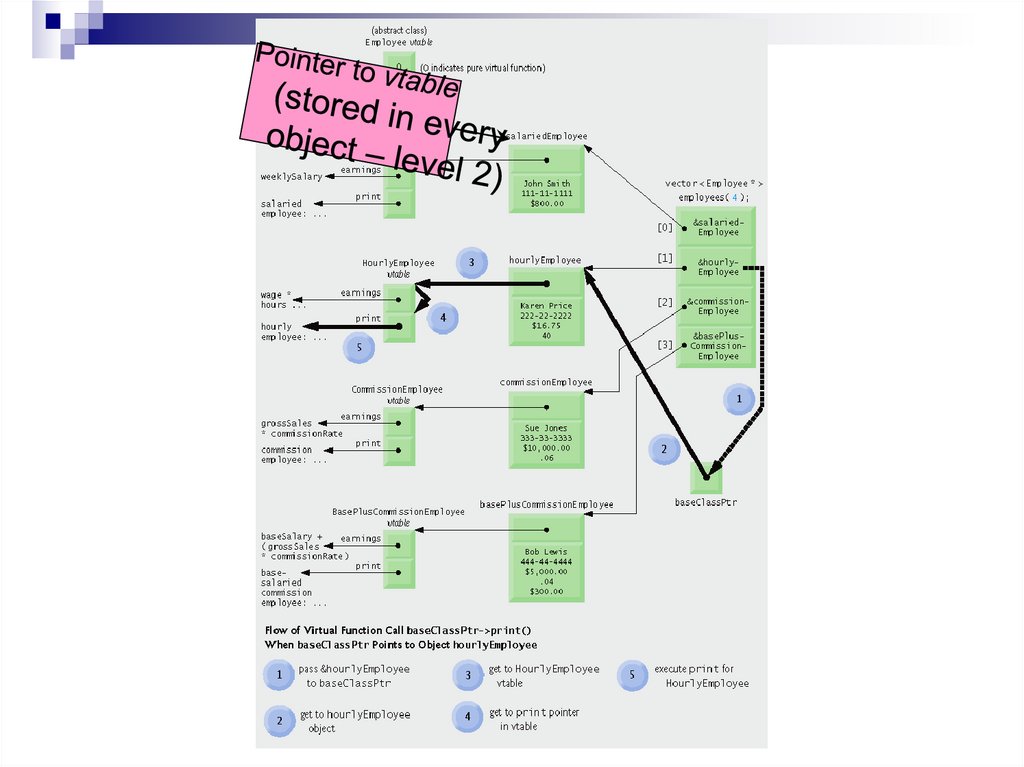Similar presentations:
Overview of the .NET
1. Overview of the .NET
2. Overview
Compilation and interpretationVirtual machines
Simple C# program
CIL, ildasm util
CLR
.NET Framework
JIT, NGEN
CLS
.NET 6
Compare C ++, C # (.NET) method call performance
2
3. Compilation (Ahead-of-Time) and interpretation
A program written in a high level language can run in twoways
Compiled into a program in the native machine language and
then run on the target machine.
Directly interpreted and the execution is simulated within an
interpreter.
3
4. Compilation and interpretation
How is a C++ program executed on linprog?How is a JavaScript program executed?
cl try.cpp compiling the program into machine code
Try.exe running the machine code
cscript.exe try.js
The program just runs, no compilation phase
The program cscript is the software environment that
understands JavaScript language. The program try.js is
executed (interpreted) within the environment.
In general, which approach is more efficient?
4
5. Compilation and interpretation
In general, which approach is more efficient?A[i][j] = 1;
Compilation:
mov eax, DWORD PTR _i$[ebp]
imul eax, 20
lea ecx, DWORD PTR _A$[ebp+eax]
mov edx, DWORD PTR _j$[ebp]
mov DWORD PTR [ecx+edx*4], 1
Interpretation:
create a software environment that
understand the language
put 1 in the array entry A[i][j];
5
6. Compilation and interpretation
In general, which approach is more efficient?A[i][j] = 1;
Compilation:
mov eax, DWORD PTR _i$[ebp]
imul eax, 20
lea ecx, DWORD PTR _A$[ebp+eax]
mov edx, DWORD PTR _j$[ebp]
mov DWORD PTR [ecx+edx*4], 1
Interpretation:
create a software environment that
understand the language
put 1 in the array entry A[i][j];
For the machine to put 1 in the array
entry A[i][j], that code sequence still
needs to be executed.
Most interpreter does a little more than
the barebone “real work.”
• Compilation is always more efficient!!
• Interpretation provides more functionality. E.g. for debugging
One can modify the value of a variable during execution.
6
7. Compilers versus Interpreters
Compilers “try to be as smart as possible” to fix decisions thatcan be taken at compile time to avoid to generate code that
makes this decision at run time
Type checking at compile time vs. runtime
Static allocation
Static linking
Code optimization
Compilation leads to better performance in general
Allocation of variables without variable lookup at run time
Aggressive code optimization to exploit hardware features
7
8. Compilers versus Interpreters
Virtual Machines(for programming language)
A virtual machine executes an instruction stream in
software
Adopted by Pascal, Java, Smalltalk-80, C#, functional
and logic languages, and some scripting languages
Pascal compilers generate P-code that can be interpreted or
compiled into object code
Java compilers generate bytecode that is interpreted by the Java
virtual machine (JVM)
C#, VB.NET compilers generate CIL (Common Intermediate
Language) that is interpreted by the CLR virtual machine
The CLR may translate CIL into machine code by just-in-time
(JIT) compilation
9
9. Virtual Machines (for programming language)
Compilation and Execution onVirtual Machines
Compiler generates intermediate program
Virtual machine interprets the intermediate program
Source
Program
Compiler
Compile on X
Input
Intermediate
Program
Run on VM
Virtual
Machine
Output
Run on X, Y, Z, …
10
10. Compilation and Execution on Virtual Machines
Two Steps Compilation ProcessCompilation is done in two steps:
At compile time: compile each language (C#,VB.Net, C++, etc)
to Common Intermediate Language (CIL)
At runtime: Common Language Runtime (CLR) uses a Just In
Time (JIT) compiler to compile the CIL code to the native code
for the device used
Compile
Time
Run
Time
11. Two Steps Compilation Process
Simple C# programnamespace SimpleConsoleApplication
{
class Program
{
static void Main(string[] args)
{
int init =10;
int rate =5;
int pos = init + rate * 60;
System.Console.WriteLine(pos);
}
}
}
12
12. Simple C# program
C# -> CIL Using ildasm.method private hidebysig static void Main(string[] args) cil managed
{ .entrypoint
.maxstack 3
.locals init ([0] int32 'init', [1] int32 rate, [2] int32 pos)
ldc.i4.s 10
stloc.0
ldc.i4.5
stloc.1
ldloc.0
ldloc.1
ldc.i4.s 60
mul
add
stloc.2
ldloc.2
call
void [mscorlib]System.Console::WriteLine(int32)
ret }
13
13. C# -> CIL Using ildasm
.maxstack 3.locals init ([0] int32 'init', [1] int32 rate, [2] int32 pos)
Local Variables
Stack
0 (init)
int
0
unused
1 (rate)
int
0
unused
2 (pos)
int
0
unused
ldc.i4.s 10
Stack
Local Variables
0 (init)
int
0
unused
1 (rate)
int
0
unused
2 (pos)
int
0
10
int
14
14.
Local VariablesStack
0 (init)
int
0
unused
1 (rate)
int
0
unused
2 (pos)
int
0
10
int
stloc.0
Local Variables
Stack
0 (init)
int
10
unused
1 (rate)
int
0
unused
2 (pos)
int
0
unused
15
15.
Local VariablesStack
0 (init)
int
10
unused
1 (rate)
int
0
unused
2 (pos)
int
0
unused
ldc.i4.5
Stack
Local Variables
0 (init)
int
10
unused
1 (rate)
int
0
unused
2 (pos)
int
0
5
int
16
16.
Local VariablesStack
0 (init)
int
10
unused
1 (rate)
int
0
unused
2 (pos)
int
0
5
int
stloc.1
Local Variables
Stack
0 (init)
int
10
unused
1 (rate)
int
5
unused
2 (pos)
int
0
unused
17
17.
Local VariablesStack
0 (init)
int
10
unused
1 (rate)
int
5
unused
2 (pos)
int
0
unused
ldloc.0
ldloc.1
Stack
Local Variables
0 (init)
.1int
10
unused
1 (rate)
int
5
5
Int
2 (pos)
int
0
10
int
18
18.
Local VariablesStack
0 (init)
int
10
unused
1 (rate)
int
5
5
int
2 (pos)
int
0
10
int
ldc.i4.s 60
Stack
Local Variables
0 (init)
int
10
60
int
1 (rate)
int
5
5
int
2 (pos)
int
0
10
int
19
19.
Local VariablesStack
0 (init)
int
10
60
int
1 (rate)
int
5
5
int
2 (pos)
int
0
10
int
mul
Stack
Local Variables
0 (init)
int
10
unused
1 (rate)
int
5
300
int
2 (pos)
int
0
10
int
20
20.
Local VariablesStack
0 (init)
int
10
unused
1 (rate)
int
5
300
int
2 (pos)
int
0
10
int
add
Stack
Local Variables
0 (init)
int
10
unused
1 (rate)
int
5
unused
2 (pos)
int
0
310
int
21
21.
Local VariablesStack
0 (init)
int
10
unused
1 (rate)
int
5
unused
2 (pos)
int
0
310
int
stloc.2
Local Variables
Stack
0 (init)
int
10
unused
1 (rate)
int
5
unused
2 (pos)
int
310
unused
22
22.
Local VariablesStack
0 (init)
int
10
unused
1 (rate)
int
5
unused
2 (pos)
int
310
unused
ldloc.2
Stack
Local Variables
0 (init)
int
10
unused
1 (rate)
int
5
unused
2 (pos)
int
310
310
int
23
23.
Local VariablesStack
0 (init)
int
10
unused
1 (rate)
int
5
unused
2 (pos)
int
310
310
int
call void mscorlib]System.Console::WriteLine(int32)
ret
Local Variables
Stack
0 (init)
int
10
unused
1 (rate)
int
5
unused
2 (pos)
int
310
unused
24
24.
Common IntermediateLanguage (CIL)
Much like the native languages of devices.
CIL was originally known as Microsoft Intermediate
Language (MSIL).
CIL is a CPU- and platform-independent instruction set.
It can be executed in any environment supporting the
.NET framework
25. Common Intermediate Language (CIL)
Common Language Runtime(CLR)
The Common Language Runtime (CLR) manages the
execution of code.
CLR uses Just-In-Time (JIT) compiler to compile the CIL
code to the native code for device used.
Through the runtime compilation process CIL code is
verified for safety during runtime, providing better
security and reliability than natively compiled binaries.
Native image generator compilation (NGEN) can be
used to produces a native binary image for the a specific
environment. What is the point?
26. Common Language Runtime (CLR)
Compilation ProcessSo if we have 3 programming languages and 3 devices,
how many compilers do we need?
Source
code
VB
C#
C++
VB Compiler
C# Compiler
C++ Compiler
CIL
CIL
CIL
Executes
under the
management
of a virtual
machine.
Common Language Runtime JIT Compiler
Native
code
Managed
Code
CLR Services
Managed
CLR
Code
Managed
Code
Operating System Services
Unmanaged
Code
27. Compilation Process
Platform and LanguageIndependent
What we have described so far will lead us to Platform
independent environment. How?
Can we use compiled classes written in X language in a
program written in Y language?
VB.NET + C#.NET code
28. Platform and Language Independent
Language interoperabilityAll .NET languages can interoperate
C# calling
VB.NET
class Hello
{
static void Main()
{
System.Console.WriteLine(Greeting.Message());
}
}
Class Greeting
Shared Function Message() As String
Return "hello"
End Function
End Class
29. Language interoperability
Execution engineCommon Language Runtime (CLR) is the execution
engine
loads IL
compiles IL
executes resulting machine code
CLR
IL
Runtime
compiler
machine code
Execute
30. Execution engine
JIT runtime compileCIL is compiled into machine code at runtime by the
CLR
compiles methods as needed
called just in time (JIT) compile
JIT compilation model:
first time method is called the IL is compiled and optimized
compiled machine code is cached in transient memory
cached copy used for subsequent calls
Cache
machine code for F()
CIL code
F()
G()
H()
JIT runtime
compiler
Execute
31. JIT runtime compile
Language variabilityNot all .NET languages have exactly the same
capabilities
differ in small but important ways
signed integer
unsigned integer
C#
class Hello
{
static void Main()
{
int i;
uint u;
}
}
VB.NET
signed integer only
Class Greeting
Shared Sub Main()
Dim i as Integer
End Sub
End Class
32. NGEN install time compile
Common LanguageSpecification
Common Language Specification (CLS) defines type
subset
required to be supported by all .NET languages
limiting code to CLS maximizes language interoperability
code limited to CLS called CLS compliant
not CLS compliant
to use uint in public
interface of public class
public class Calculator
{
public uint Add(uint a, uint b)
{
return a + b;
}
}
33. Language variability
CLS,CLR/CTS & LanguagesLanguages offer a subset of the CLR/CTS and a superset of the CLS
(but not necessarily the same superset).
35
34. Common Language Specification
35. CLS,CLR/CTS & Languages
3736.
3837.
Method call performanceLet's compare C ++, C # (.NET) method call performance
C++ Function
C++ Virtual Function
C# (.NET) Method
39
38.
4039. Method call performance
4140.
Deitel & Deitel, Fig 242
41.
Calling a method for the firsttime
Console
Managed EXE
Shared Sub Main()
Console.WriteLine(“Paul”)
Console.WriteLine(“Cross”)
End Sub
Shared Sub WriteLine()
Jitter
Shared Sub WriteLine(String)
Jitter
(remaining members
…
)
MSCorEE.dll
Function Jitter
1. In the assembly that implements the type (Console), look up the method (WriteLine)
being called in the metadata.
2. From the metadata, get the IL for this method.
3. Allocate a block of memory.
4. Compile the IL into native code; save the code in the memory allocated in step 3.
5. Modify the method’s entry in the Type’s table so that it now points to the memory block
allocated in step 3.
6. Jump to the native code contained inside the memory block.
End Function
Native code
42.
Performance ImpactCall Number
C++
C++ Virtual
.NET
1
X
X + 2 pointers
X+ 2 pointers+
JIT compile
2,3…..
X
X + 2 pointers
X+ 2 pointers










































 programming
programming








